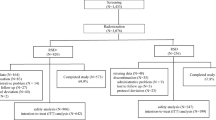Abstract
The purpose of this open, prospective, controlled, randomized trial was to study the effect of intermittent, cyclic etidronate on the bone mass of osteoporotic postmenopausal women with or without fractures. Eligible subjects were asymptomatic women less than 75 years old who had been amenorrhoeic for at least 1 year. Those with secondary osteoporosis were excluded. Subjects also had to be ambulant with a bone mineral density (BMD) of the lumbar spine >1 SD below that of age matched controls (Z-score < −1 SD). Eighty patients were enrolled, of whom 65 were recruited through a screening programme conducted in the practices of two general practitioners. The remaining patients were from other referrals. The subjects were randomized to two groups of 40 women. Treatment regimens were as follows. The etidronate group was treated with etidronate 400 mg once daily for 14 days followed by 76 days of 500 mg of elementary calcium once daily; this cycle was repeated every 3 months. The calcium group took 500 mg of elementary calcium once daily. The groups were not different in age, height, weight, time since menopause, BMD at baseline and prevalent vertebral fractures. In 50 patients (28 in the etidronate group and 22 in the calcium group) no vertebral fractures were present (67%). Sixty-four patients (35 in the etidronate group and 29 in the calcium group) completed the 3 years of the study. In the etidronate group the mean BMD of the lumbar spine, femoral neck, trochanter and Ward's triangle increased by 5.7%, 1.4%, 7.1% and 10.9% from baseline values respectively (p<0.05 at all sites except for the femoral neck). In the calcium group no significant changes from baseline were found at any time point at any site after 3 years, except for the femoral neck, where BMD at 156 weeks decreased significantly by 3% (p<0.003). In 3 patients, all in the calcium group, six new fractures were found. There were no serious adverse effects. We conclude that intermittent, cyclic treatment with etidronate causes a significant increase in the BMD of the lumbar spine and the proximal femur in osteopenic postmenopausal women, and that treatment is safe and has no serious adverse effects.
Similar content being viewed by others
References
Consensus Development Conference: Diagnosis, prophylaxis, and treatment of osteoporosis. Conference report. Am J Med 1993; 94:646–50.
Kanis JA, Melton LJ, Christiansen C, Johnston CC, Khaltaev N. The diagnosis of osteoporosis. J Bone Miner Res 1994;9:1137–41.
Recker RR, Lappe JM, Davies KM, Kimmel DB. Change in bone mass immediately before menopause. J Bone Miner Res 1992;7:857–62.
Matkovic V, Jelic T, Wardlaw GM, Ilich JZ, Goel PK, Wright JK, et al. Timing of peak bone mass in Caucasian females and its implication for the prevention of osteoporosis. J Clin Invest 1994;93:799–808.
Storm T, Thamsborg G, Steiniche T, Genant HK, Sorensen OH. Effect of intermittent cyclical etidronate therapy on bone mass and fracture rate of women with postmenopausal osteoporosis. N Engl J Med 1990;322:1265–71.
Watts NB, Harris ST, Genant HG, Wasnich RD, Miller PD, Jackson RD, et al. Intermittent cyclical etidronate treatment of postmenopausal osteoporosis. N Engl J Med 1990;323:73–9.
Harris ST, Watts NB, Jackson RD, Genant HK, Wasnich RD, Ross P, et al. Four-year study of intermittent cyclical etidronate treatment of postmenopausal osteoporosis: three years of blinded therapy followed by one year of open therapy. Am J Med 1993;95:557–67.
Genant HK, WU CY, van Kuijk C, Nevitt MC. Vertebral fracture assessment using a semiquantitative technique. J Bone Miner Res 1993;8:1137–48.
Hulshof KFAM, van der Heiden-Winkeldermaat HJ, Kistemaker C, van Beresteyn ECH. Calcium intake from dairy products: assessment by a semiquantitative food frequency method. Voeding 1989;50:302–6.
Wahner HW, Fogelman I. The evaluation of osteoporosis: dual energy X-ray absorptiometry in clinical practice. London, Martin Dunitz, 1994:143.
Author information
Authors and Affiliations
Rights and permissions
About this article
Cite this article
Montessori, M.L.M., Scheele, W.H., Netelenbos, J.C. et al. The use of etidronate and calcium versus calcium alone in the treatment of postmenopausal osteopenia: Results of three years of treatment. Osteoporosis Int 7, 52–58 (1997). https://doi.org/10.1007/BF01623461
Received:
Accepted:
Issue Date:
DOI: https://doi.org/10.1007/BF01623461




